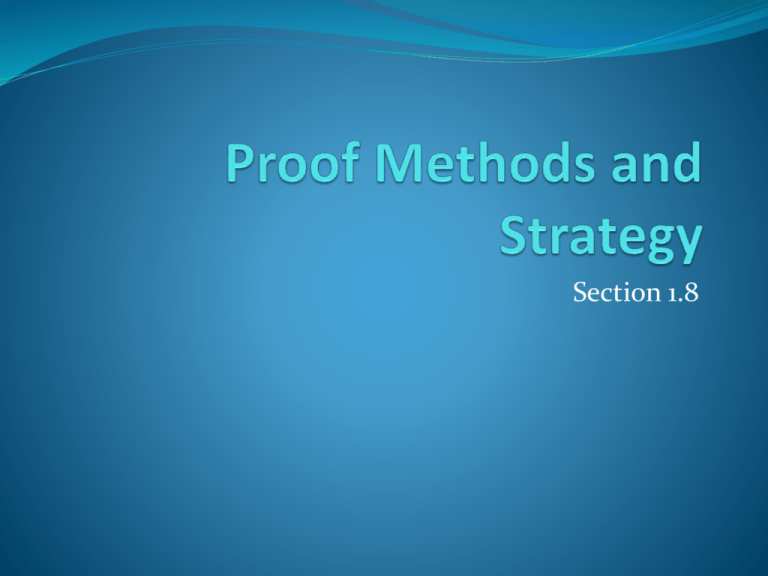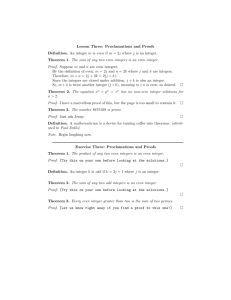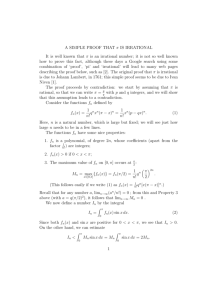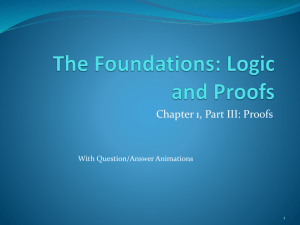Document
advertisement

Section 1.8
Proof by Cases
Example: Let a @ b = max{a, b} = a if a ≥ b, otherwise
a @ b = max{a, b} = b.
Show that for all real numbers a, b, c
(a @b) @ c = a @ (b @ c)
(This means the operation @ is associative.)
Proof: Let a, b, and c be arbitrary real numbers.
Then one of the following 6 cases must hold.
1. a ≥ b ≥ c
2. a ≥ c ≥ b
3. b ≥ a ≥c
4. b ≥ c ≥a
5. c ≥ a ≥ b
6. c ≥ b ≥ a
Continued on next slide
Proof by Cases
Case 1: a ≥ b ≥ c
(a @ b) = a, a @ c = a, b @ c = b
Hence (a @ b) @ c = a = a @ (b @ c)
Therefore the equality holds for the first case.
A complete proof requires that the equality be shown
to hold for all 6 cases. But the proofs of the
remaining cases are similar. Try them.
Without Loss of Generality
Example: Show that if x and y are integers and both x∙y and x+y are even,
then both x and y are even.
Proof: Use a proof by contraposition. Suppose x and y are not both even.
Then, one or both are odd. Without loss of generality, assume that x is odd.
Then x = 2m + 1 for some integer k.
Case 1: y is even. Then y = 2n for some integer n, so
x + y = (2m + 1) + 2n = 2(m + n) + 1 is odd.
Case 2: y is odd. Then y = 2n + 1 for some integer n, so
x ∙ y = (2m + 1) (2n + 1) = 2(2m ∙ n +m + n) + 1 is odd.
We only cover the case where x is odd because the case where y is odd is
similar. The use phrase without loss of generality (WLOG) indicates this.
Existence Proofs
Proof of theorems of the form
.
Constructive existence proof:
Find an explicit value of c, for which P(c) is true.
Example: Show that there is a positive integer that can be
written as the sum of cubes of positive integers in two different
ways:
Proof:
1729 is such a number since
1729 = 103 + 93 = 123 + 13
Nonconstructive Existence Proofs
Example: Show that there exist irrational numbers x
and y such that xy is rational.
Proof: We know that √2 is irrational. Consider the
number √2 √2 . If it is rational, we have two irrational
numbers x and y with xy rational, namely x = √2
and y = √2. But if √2 √2 is irrational,
then we can let x = √2 √2 and y = √2 so that
aaaaa xy = (√2 √2 )√2 = √2 (√2 √2) = √2 2 = 2.
Uniqueness Proofs
Some theorems asset the existence of a unique element with a
particular property, !x P(x). The two parts of a uniqueness proof
are
Existence: We show that an element x with the property exists.
Uniqueness: We show that if y≠x, then y does not have the property.
Example: Show that if a and b are real numbers and a ≠0, then
there is a unique real number r such that ar + b = 0.
Solution:
Existence: The real number r = −b/a is a solution of ar + b = 0
because a(−b/a) + b = −b + b =0.
Uniqueness: Suppose that s is a real number such that as + b = 0.
Then ar + b = as + b, where r = −b/a. Subtracting b from both
sides and dividing by a shows that r = s.
The Role of Open Problems
Unsolved problems have motivated much work in
mathematics. Fermat’s Last Theorem was conjectured
more than 300 years ago. It has only recently been
finally solved.
Fermat’s Last Theorem: The equation xn + yn = zn
has no solutions in integers x, y, and z, with xyz≠0
whenever n is an integer with n > 2.
A proof was found by Andrew Wiles in the 1990s.
An Open Problem
The 3x + 1 Conjecture: Let T be the transformation
that sends an even integer x to x/2 and an odd integer
x to 3x + 1. For all positive integers x, when we
repeatedly apply the transformation T, we will
eventually reach the integer 1.
For example, starting with x = 13:
T(13) = 3∙13 + 1 = 40, T(40) = 40/2 = 20, T(20) = 20/2 = 10,
T(10) = 10/2 = 5, T(5) = 3∙5 + 1 = 16,T(16) = 16/2 = 8,
T(8) = 8/2 = 4, T(4) = 4/2 = 2, T(2) = 2/2 = 1
The conjecture has been verified using computers up
to 5.6 ∙ 1013 .
An Open Problem
Goldbach’s Conjecture: Every even integer greater
than 2 can be expressed as the sum of two primes.


![Question 1. Let y be a positive number. Prove that [ ] = [ ]. Proof. If y](http://s3.studylib.net/store/data/007965868_1-f602f124542fbf21e7243a49f380ea21-300x300.png)


